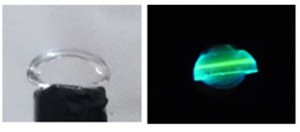Paper: Mechanisms of optical losses inthe 5D4 and 5D3 levels in Tb3+ doped low silica calcium aluminosilicate glasses. J. F. M. dos Santos, I. A. A. Terra, N. G. C. Astrath, F. B. Guimarães, M. L. Baesso, L. A. O. Nunes and T. Catunda. J. Appl. Phys. 117, 053102 (2015). DOI: 10.1063/1.4906781.
A team of scientists from Brazilian institutions has expanded the comprehension of the mechanisms that restrict the light emission efficiency in materials doped with trivalent terbium ion (Tb³+). This ion, found in the rare earth group, subgroup of lanthanides, displays luminescent emissions from ultraviolet to infrared. Its intense green emission, with approximately 545 nm of wave length, is particularly interesting for technological purposes.
Some years ago, for instance, Japanese researchers produced laser emissions with Tb3+ doped optical fibers. However, their device displayed low efficiency, due to the saturation of its optical gain, even at low excitation levels.

Taking up this technological issue, the team of Brazilian scientists has conducted a thorough study on the processes that cause the saturation of the green emission. For that, they used Tb3+ to dope a material which, thanks to its properties, ensures high efficiency to the emission, mainly in infrared: the low silica calcium aluminosilicate glass, also known as LSCAS.
The study involved two research groups that have been collaborating for approximately two decades, the group of spectroscopy of solids from the São Carlos Institute of Physics at the São Paulo University (USP), and the photothermics group from State University of Maringá (UEM). The results were reported in a paper that appeared recently on the Journal of Applied Physics.
Firstly, glass samples with different dopant concentrations were prepared by the UEM group.

At IFSC-USP, the samples were excited using a laser at two different wavelengths, 488 nm (visible) and 325 nm (ultraviolet), and their absorption, emission and excitation spectra were obtained. Analyzing them, the scientists from the group of spectroscopy of solids observed certain particularities in the behavior of some luminescent emissions, such as a strong saturation in a green emission, similar to the one found in the laser presented by the Japanese scientists. In other wavelengths, they noted, for example, a decrease in luminescence occurring at lower excitation levels than expected. Thus, the researchers managed to conclude that the mechanism associated in the literature to the emissions from Tb3+ doped materials, also known as cross relaxation, was not enough to completely explain the behavior of the emissions or even the saturation of the green emissions, and proposed the additional action of other processes.
“Additional loss mechanisms, such as emissions by defects in the matrix, energy upconversion processes, to name a few, have a significant influence in the system we have studied”, explains Tomaz Catunda, professor at USP and corresponding author of the article. “These decay paths, previously ignored by the literature, are very important in the manufacturing of optical devices with Tb3+ doped materials”, he adds.
The study of Tb³+ doped glasses by the Brazilian team started during the Doctoral dissertation of Idelma Terra, defended in 2013 at USP, which aimed to develop materials in order to increase the efficiency of solar cells. Her work was granted the 2014 “Vale-Capes Science and Sustainability Award”. The study of these materials continued in Giselly Bianchi’s Doctoral dissertation, performed at UEM, and in the Master’s thesis of Jéssica Fabiana Mariano dos Santos, defended in 2014 at EESC-USP.
The article published on the Journal of Applied Physics has joined dozens of papers born from the collaboration between the groups of spectroscopy of solids and photothermics, in some cases also involving other scientists from Brazil and abroad, focused on the optical spectroscopy of calcium aluminate glasses doped with rare earth ions and their applications in light-emitting devices.
